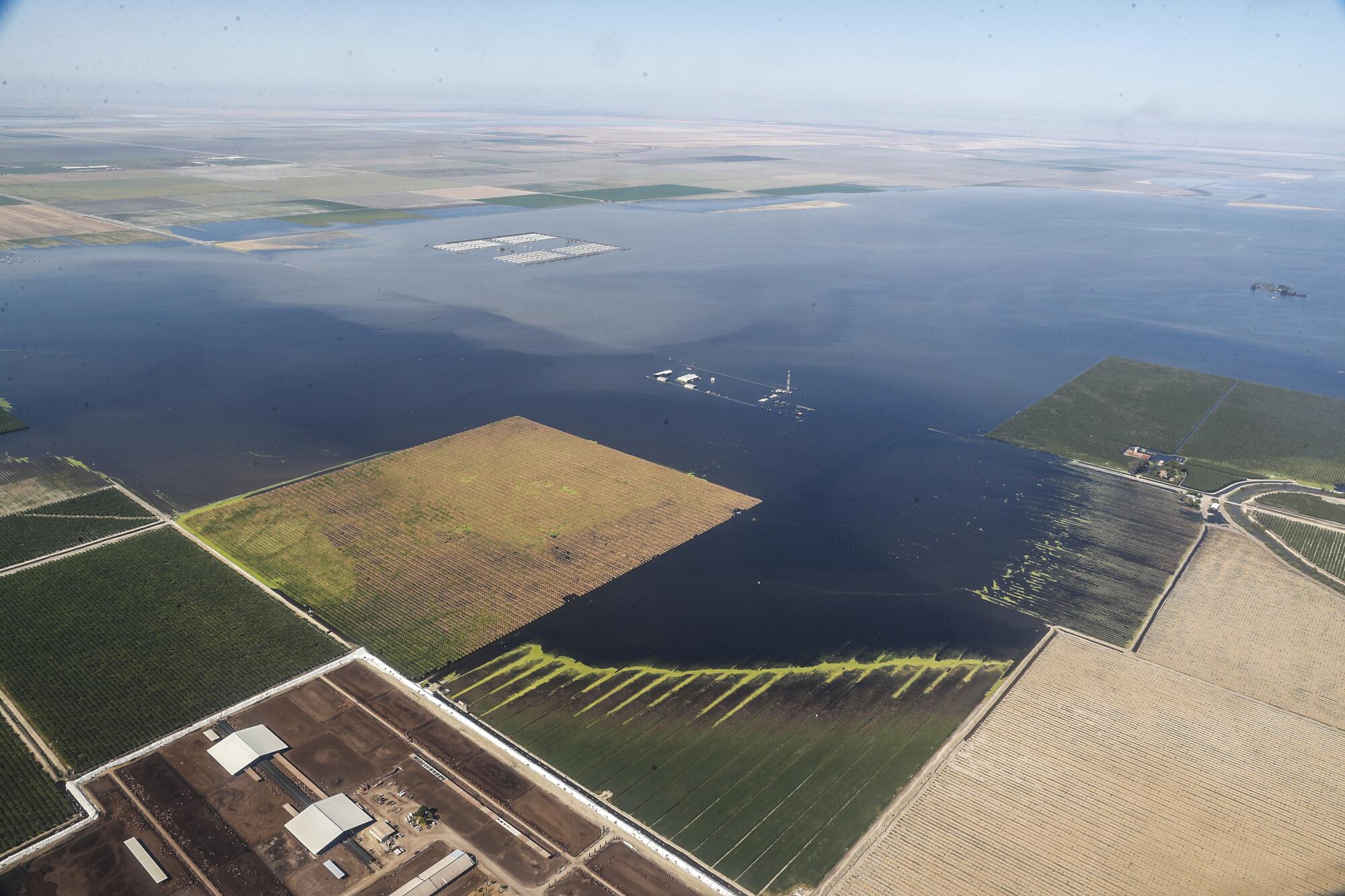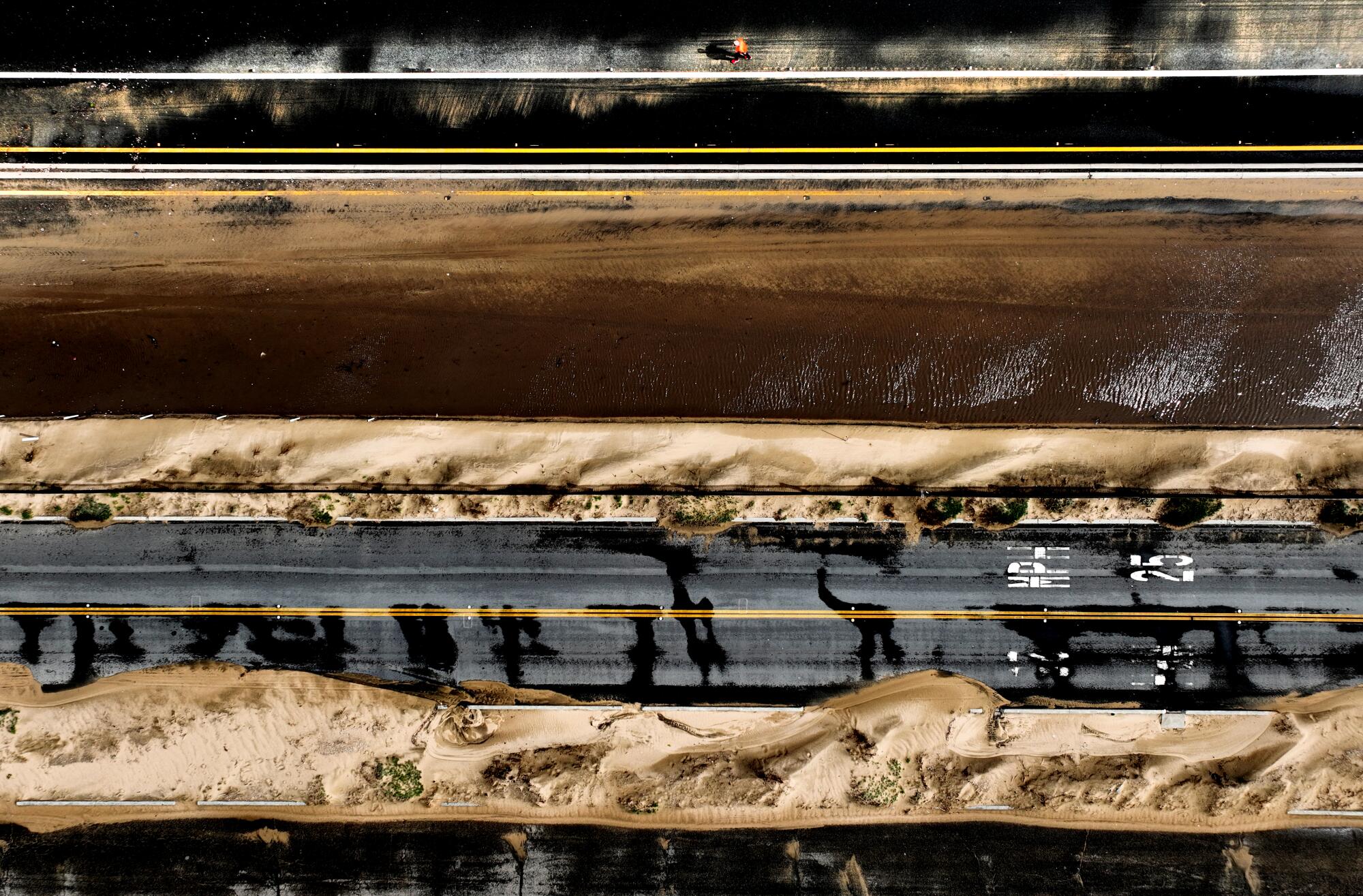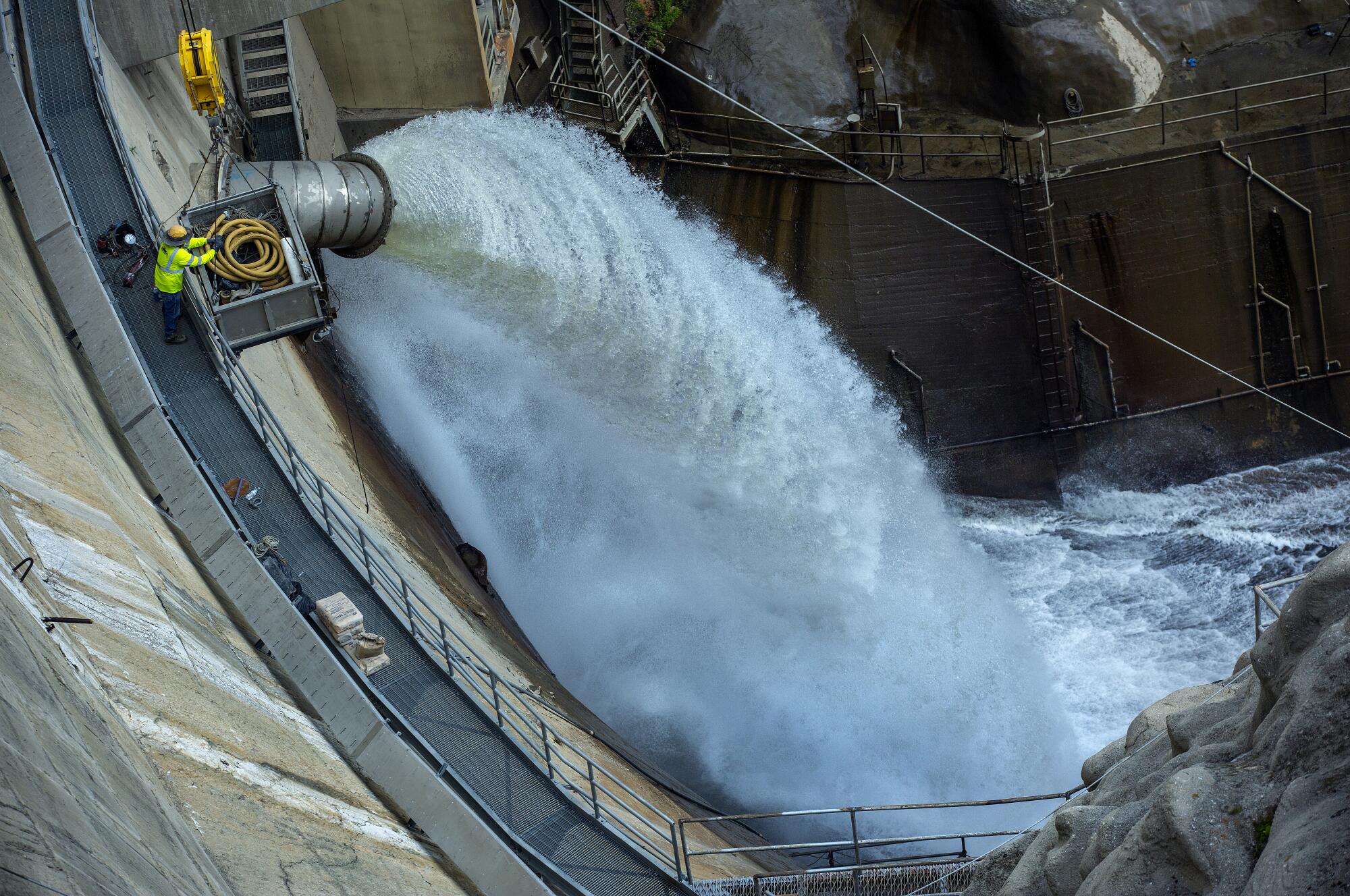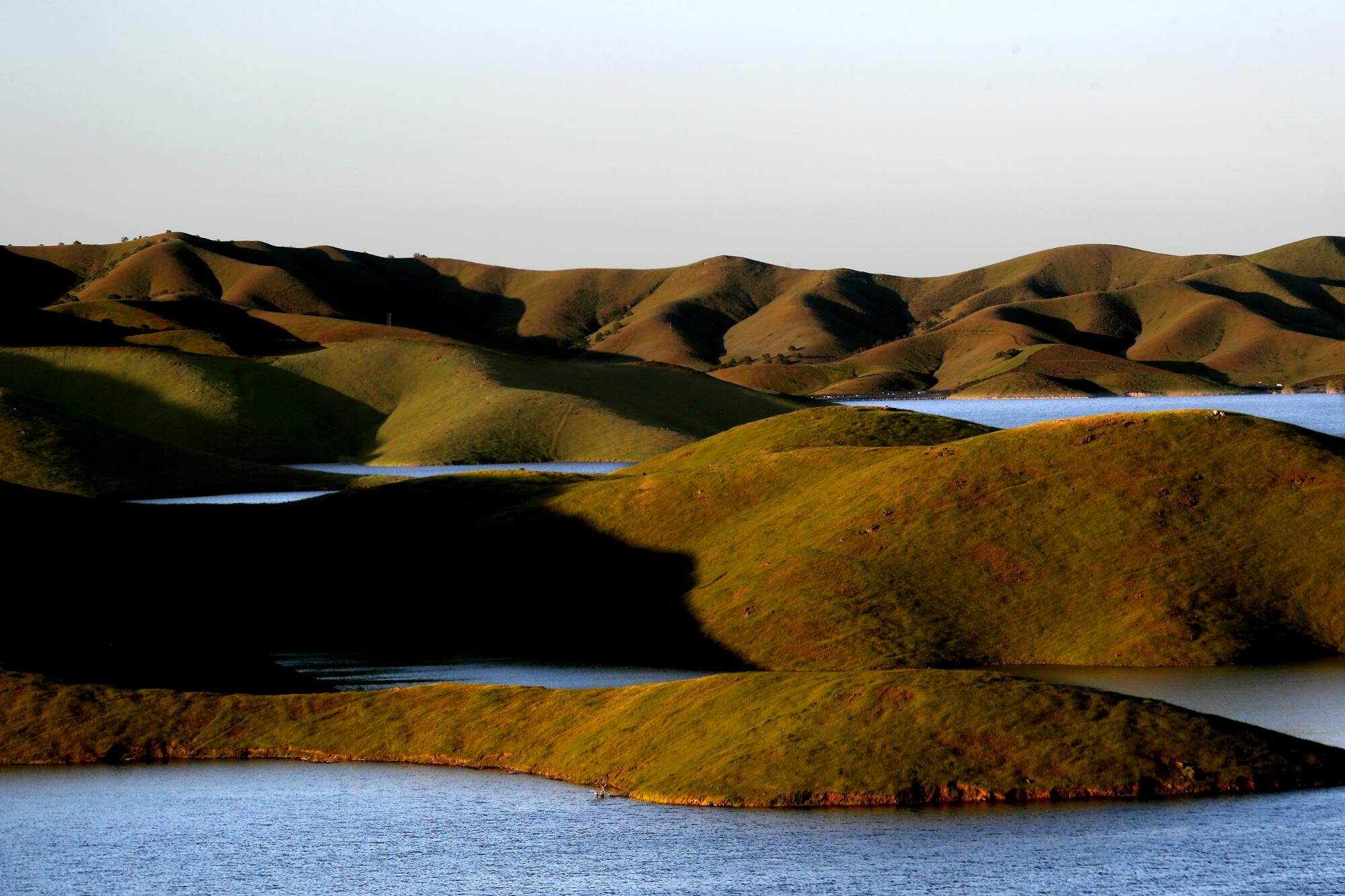The sometimes parched, brown hills above Los Angeles are a vibrant shade of inexperienced — a rarity for early October.
In state parks, waterfalls and rivers that had been vastly diminished are actually gushing with water.
And in Lake Oroville, boats float on deep blue water that solely a yr in the past was shrinking towards report lows.
The remodeled panorama is the results of a outstanding California water yr that noticed 141% of common rainfall statewide, officers introduced this week. The state acquired 33.56 inches of rain — almost twice the quantity of rain recorded through the earlier water yr and almost 3 times the quantity from the yr prior. The water yr runs from Oct. 1 to Sept. 30.
“This was as near a miracle yr as you may get following the depth of drought situations,” stated Karla Nemeth, director of the Division of Water Assets, throughout a briefing Tuesday. The three earlier years had been California’s driest on report.
Aggressive and impactful reporting on local weather change, the atmosphere, well being and science.
However with abundance comes threat: Forecasters are warning of one other probably moist winter fueled by El Niño, which might convey levee breaches and flooding to the state as soon as once more.
“Mom Nature actually helped us out, and she or he did assist us out in a very, actually large method in sure elements of the state,” Nemeth stated. “However there are all the time methods during which Mom Nature can throw us a curve ball, and we shouldn’t count on that essentially once more. There’s loads of work to proceed to be finished — notably with regards to flooding and defending our communities.”
This yr’s soggy situations had been due primarily to 31 atmospheric river storms that unleashed torrents on the Golden State this winter and spring, in addition to a really moist August marked by the uncommon arrival of Tropical Storm Hilary.

After shrinking to perilous lows, Lake Oroville refilled in a dramatic style as a consequence of historic rains this water yr.
(Brian van der Brug / Los Angeles Instances)
The deluge replenished main reservoirs that solely a yr in the past had been dangerously low. State reservoirs are actually holding about 27.4 million acre-feet in storage, or 128% of regular. That features California’s two largest reservoirs, Lake Shasta and Lake Oroville, that are each at 73% capability. On the similar time final yr, they had been at 33% and 35% capability, respectively.
Oroville’s enhance was notably dramatic, stated Ted Craddock, the DWR’s deputy director of the State Water Mission. Between December and the tip of the snowmelt interval this spring, the reservoir gained greater than 240 toes in elevation — “the biggest enhance we’ve seen in Oroville storage in a season … for the reason that lake was constructed within the Nineteen Sixties.”
The distinction between now and a yr in the past is “like evening and day,” stated Jay Lund, a professor of civil and environmental engineering at UC Davis.
“This yr was a great reminder that we do have this super variability in water availability in California,” he stated.
Many elements of Central and Southern California noticed primarily “two seasons in a single,” or greater than 200% of regular, in response to the Nationwide Climate Service.
For instance, a climate station at USC in Los Angeles recorded 31.07 inches — greater than twice the world’s regular rainfall of 14.25 inches a yr, the company stated. Ontario and Fullerton every noticed about 25 inches in contrast with their regular 12 inches.
The water yr additionally noticed report snow. At its peak on April 1, snowpack measured 237% of regular — the deepest ever recorded for the reason that state established a community of snow sensors within the mid-Eighties.
Water was so plentiful that officers with the Metropolitan Water District had been capable of refill Southern California’s largest reservoir, Diamond Valley Lake, for the primary time in a number of years, with Basic Supervisor Adel Hagekhalil exclaiming on the time that “nature gave us a lifeline.”
However whereas California has been identified to swing from moist to dry, local weather change is making each situations extra excessive. So-called “common” years are additionally prone to turn out to be much less frequent, Lund stated.
“Our discussions about water are usually a bit fickle,” he stated. “If it’s a dry yr, we’ll speak about drought, or if it’s a moist yr, we’ve these issues with floods. However actually, we have to fear about each in any yr and yearly.”
Certainly, after the state’s three driest years on report, officers this yr scrambled to maintain up with all of the rain. As storms hammered California, a number of levees breached and despatched water dashing into cities and communities, together with the small migrant neighborhood of Pajaro. 1000’s of properties had been flooded, and by the point the storms dissipated, at the least 22 folks had died throughout the state.
Within the San Joaquin Valley, the long-dry Tulare Lake reemerged for the primary time since 1997, leaving low-lying fields buried below deep and stagnant water.
State officers on Tuesday stated the occasions had been a wake-up name to the challenges of forecasting in a quickly altering local weather, and the necessity for better preparation for each moist and dry situations.

An aerial view of the jap banks of Tulare Lake in March.
(Robert Gauthier / Los Angeles Instances)
“We’ve all the time had intense variability in California, however the suddenness of the shift from ‘very excessive dry’ to ‘very excessive moist’ is one thing that we expect wants extra analysis to know how adjustments within the local weather could have performed an element, or not, in that excessive shift,” Nemeth stated.
Including to the problem is the potential of a powerful El Niño occasion this winter. The local weather sample is usually related to wetter situations in Southern California, however is much less informative about Northern California, which is the place many of the state’s water provide comes from.
Nonetheless, the potential of extra storms — notably alongside the coast — is trigger for concern, officers stated. Storms coming straight off the Pacific might equate to extra coastal impacts like these seen in Pajaro.
“The coast was notably hit onerous, and that retains me awake a bit bit at evening with going into an El Niño yr,” stated Gary Lippner, DWR’s deputy director of flood administration and dam security. “I believe there’s potential for lots of sturdy storms to come back into California and have coastal points. And we simply would not have in depth flood programs on the coast of California, in order that’s an space that we’re paying explicit consideration to going into this yr.”
Among the many state’s preparations are $52 million in funding to help with native flood tasks and important levee repairs. The state can also be readying extra flood management materials than final yr, together with extra “muscle wall” — or materials to assist shore up levees and include water — and a couple of.4 million extra sandbags, officers stated.

A stretch of Pacific Coast Freeway in Huntington Seashore was closed in March as a consequence of flooding between Warner Avenue and Seapoint Avenue.
(Allen J. Schaben/Los Angeles Instances)
“We actually are going to focus this yr on the timing, the tempo and the dimensions of the storms when that storm door is open,” stated state climatologist Mike Anderson.
He famous that the state and federal officers are additionally using new expertise, together with atmospheric river reconnaissance flights, which acquire storm information and assist enhance forecasting, and laser spectrometry to assist measure snowpack and higher predict runoff.
Lund, of UC Davis, stated that whereas giant cities are usually pretty nicely defended in opposition to flooding, many smaller locations corresponding to Pajaro aren’t adequately protected.
“These floods and droughts establish weaknesses within the system,” he stated. “Hopefully, the failures will convey us to motion on a few of these.”
Along with flood threats, the abundance of water this yr additionally led many to query whether or not the state was doing sufficient to seize all of that water — together with some lawmakers who known as for officers to calm down environmental pumping restrictions that restricted the quantity of water that might be captured from the Sacramento-San Joaquin River Delta through the storms.
In March, the State Water Assets Management Board authorized a plan to divert some floodwaters from the San Joaquin River to replenish aquifers that had been depleted by agricultural pumping and years of drought. Practically 400,000 acre-feet was diverted from the river and despatched to areas the place it might unfold out and percolate down into the bottom, with an extra 1.2 million acre-feet in momentary permits issued by state companies.

Water is launched at 15 cubic toes per second from the Santa Anita Dam in January.
(Mel Melcon / Los Angeles Instances)

Water fills coves alongside the shore of the San Luis Reservoir, close to Los Banos, in April, following a collection of heavy rainstorms.
(Luis Sinco / Los Angeles Instances)
However whereas groundwater storage noticed a lift this yr, it should take a couple of moist season to replenish provides which have been sapped by years of overuse and drought. Aquifers in some elements of the state — notably closely agricultural areas of the Central Valley — stay a lot under regular, state information present.
“It should probably require a number of extra years along with what occurred this previous yr — and extra centered efforts on groundwater recharge and diminished demand,” stated Paul Gosselin, DWR’s deputy director of sustainable groundwater administration.
And whereas winter seems to be probably moist, the state can also be contending with warming situations that might additional sap provides. June, July and August marked the warmest summer season on report for the Northern Hemisphere, whereas September broke world warmth information by a big margin.
In the interim, nevertheless, a lot of California’s panorama stays considerably drenched, together with elements of Southern California that acquired a number of inches of rain in August from Hilary. That might sign an finish to this yr’s delicate fireplace season, though consultants warning that drying winds might change the outlook shortly.
The moist yr “definitely dampened the chance of fires for a lot of the state,” Lund stated. “I’d a lot reasonably have had the rains than not.”
#Californias #water #yr #ended #precipitation #stacked